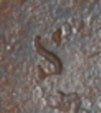
This is a good question that was put to me recently by a Kenora
Chester Huff claims to know a secret spot on the Lake of the Woods, some distance from the original 'Rat Portage' (referencing the 1821 sketch by James Bigsby), and boasts that he's now excavating the remains of the area's first fur trading post!
But
FUR TRADE RELIC #1
Trade axes are the most essential Fur Trade relic, and that's because the axe is such a versatile tool.
Native Americans used the artifact everyday for all manner of chopping tasks. And they had ceremonial applications, and could also be used as weapons. In the 1600s - 1750s these iron axes were imported from
Early "eyes" were round holes. Later the eyes became oval shaped, or tear-dropped and later still rectangular. Handles or helves were made by the natives, but there are first hand accounts of the Voyageurs or courier du bois relaxing against beached 42 foot Montrealers, whittling small hardwood limbs into handles by the campfire at night. Many axe heads bear their parent metalworkers marks - these are commonly referred to as "touch marks". Touch marks are made by touching the axe head when it's red hot, and leaving a mark on the metal. Cast or factory made axe heads with makers' marks are often referred to as guild marks. The most commonly found style of axe heads known are the Biscay style, since they were manufactured in the Biscay region of
Touch marks are made by touching the axe head when it's red hot, and leaving a mark on the metal. Cast or factory made axe heads with makers' marks are often referred to as guild marks. The most commonly found style of axe heads known are the Biscay style, since they were manufactured in the Biscay region of
Many different sizes and shapes of trade axes were found in the underwater search conducted at Double Rapids on the  How much is a genuine 1700's trade ax worth these days? Well let’s investigate that... The very best way to track an authentic trade ax's value would be to find a genuine 1700's trace axe on eBay, and wait to see who pays what, (and where they live.) *Question for the comments: Would you sell a
How much is a genuine 1700's trade ax worth these days? Well let’s investigate that... The very best way to track an authentic trade ax's value would be to find a genuine 1700's trace axe on eBay, and wait to see who pays what, (and where they live.) *Question for the comments: Would you sell a

""One hundred and twenty some axe heads were found in crates in a sunken long boat by amateur divers. These finds were donated to the Royal Ontario Museum in August, 1964.""
ReplyDeleteWere the 'crates' recovered and conserved? I am intrested in the construction techniques of boxes from this time period 1690-1720. Any information on if they were dovetailed, or nailed, pegged, etc?
well I guess you'll have to get a hold of someone at the ROM and ask about all the particulars of the French River trade ax consignment of 1964 as I haven't seen the crates myself.
ReplyDeleteFascinating research subject though, I've sometimes wondered about jointers or 'wood joiners' and their specialized evolution as ship's carpenters. I'm sure there's a lot of medieval design history in European colonial woodworking tools.